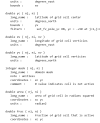It doesn't matter if you've regridded. You would still want to apply an area (cosine(lat)) weighting. If you're wanting to calculate the area sum then of course you would need to account for the different size of your grid box after regridding. But if you're wanting to calculate the area average, you would just do the same thing - average with a cos(lat) weighting applied.
I have downloaded the tas data of the hist-aer experiment of the CESM2 model. Among them, it records: "float tas(time=180, lat=192, lon=288); _:FillValue = 1.0E20f;" // float
:cell_measures = "area: areacella";
:cell_methods = "area: time: mean";
:comment = "TREFHT";
:coordinates = "time lat lon";
:description = "near-surface (usually, 2 meter) air temperature";
:frequency = "mon";
:id = "tas";
:long_name = "Near-Surface Air Temperature";
:mipTable = "Amon";
:missing_value = 1.0E20; // double
:out_name = "tas";
:prov = "Amon ((isd.003))";
:realm = "atmos";
:standard_name = "air_temperature";
:time = "time";
:time_label = "time-mean";
:time_title = "Temporal mean";
:title = "Near-Surface Air Temperature";
:type = "real";
:units = "K";
:variable_id = "tas";
:_ChunkSizes = 1U, 192U, 288U; // The "uint" in this context is "cell_methods = "area: time: mean";" Does this indicate that when calculating the average of a region, only the number of grid points needs to be applied? Is it redundant to want to use weighted methods to calculate the average of a region?

